Fluid Vents, Flank Instability, and Seafloor Processes along the Submarine Slopes of the Somma-Vesuvius Volcano, Eastern Tyrrhenian Margin
Abstract
:1. Introduction
2. Geological Background
3. Data and Methods
4. Results and Discussion
4.1. General Morphology
4.2. Seafloor Bedforms
4.2.1. Wavy Bedforms
4.2.2. Buried and Outcropping Volcanic Features
4.2.3. Depositional Bodies due to Potential Lateral Collapses
4.2.4. Degassing Features and Associated Soft-Sediment Deformation Structures
4.2.5. Bocca dei Pescatori: Maar or Sinkhole?
5. Conclusions
Acknowledgments
Author Contributions
Conflicts of Interest
References
- Del Pezzo, E.; Bianco, F.; Saccorotti, G. Seismic source dynamics at Vesuvius volcano, Italy. J. Volcanol. Geotherm. Res. 2004, 133, 23–39. [Google Scholar] [CrossRef]
- Saccorotti, G.; Petrosino, S.; Bianco, F.; Castellano, M.; Galluzzo, D.; La Rocca, M.; Del Pezzo, E.; Zaccarelli, L.; Cusano, P. Seismicity associated with the 2004–2006 renewed ground uplift at Campi Flegrei Caldera, Italy. Phys. Earth Planet. Inter. 2007, 165, 14–24. [Google Scholar] [CrossRef] [Green Version]
- Albanese, S.; De Vivo, B.; Lima, A.; Cicchella, D.; Civitillo, D.; Cosenza, A. Geochemical baselines and risk assessment of the Bagnoli brownfield site coastal sea sediments (Naples, Italy). J. Geochem. Explor. 2010, 105, 19–33. [Google Scholar] [CrossRef]
- Menghan, W.; Stefano, A.; Annamaria, L.; Cannatelli, C.; Cosenza, A.; Lu, W.; Sacchi, M.; Doherty, A.; De Vivo, B. Compositional analysis and pollution impact assessment: A case study in the Gulfs of Naples and Salerno. Estuar. Coast. Shelf Sci. 2015, 160, 22–32. [Google Scholar] [CrossRef]
- Matano, F.; Pignalosa, A.; Marino, E.; Esposito, G.; Caccavale, M.; Caputo, T.; Sacchi, M.; Somma, R.; Troise, C.; De Natale, G. Laser scanning application for geostructural analysis of tuffaceous coastal cliffs: The case of Punta Epitaffio, Pozzuoli Bay, Italy. Eur. J. Remote Sens. 2105, 48, 615–637. [Google Scholar] [CrossRef]
- Caccavale, M.; Matano, F.; Sacchi, M. An integrated approach to earthquake-induced landslide hazard zoning based on probabilistic seismic scenario for Phlegrean Islands (Ischia, Procida and Vivara), Italy. Geomorphology 2017, 295, 235–259. [Google Scholar] [CrossRef]
- Tinti, S.; Pagnoni, G.; Piatanesi, A. Simulation of tsunamis induced by volcanic activity in the Gulf of Naples (Italy). Nat. Hazards Earth Syst. Sci. 2003, 3, 311–320. [Google Scholar] [CrossRef]
- Passaro, S.; Tamburrino, S.; Vallefuoco, M.; Tassi, F.; Vaselli, O.; Giannini, L.; Chiodini, G.; Caliro, S.; Sacchi, M.; Luca Rizzo, A.; et al. Seafloor doming driven by degassing processes unveils sprouting volcanism in coastal areas. Sci. Rep. 2016, 6, 22448. [Google Scholar] [CrossRef] [PubMed]
- Milia, A.; Molisso, F.; Raspini, A.; Sacchi, M.; Torrente, M.M. Syn-eruptive features and sedimentary processes associated with pyroclastic currents entering the sea: The 79 AD eruption of Vesuvius, Naples Bay, Italy. J. Geol. Soc. 2008, 165, 839–848. [Google Scholar] [CrossRef]
- Piochi, M.; Bruno, P.P.; De Astis, G. Relative roles of rifting tectonics and magma ascent processes: Inferences fromgeophysical, structural, volcanological, and geochemical data for the Neapolitan volcanic region (southern Italy). Geochem. Geophys. Geosyst. 2005, 6. [Google Scholar] [CrossRef]
- Orsi, G.; Di Vito, M.A.; Isaia, R. Volcanic hazard assessment at the restless Campi Flegrei caldera. Bull. Volcanol. 2006, 66, 514–530. [Google Scholar] [CrossRef]
- Vezzoli, L. Island of Ischia. In Quaderni della “Ricerca Scientifica”; Consiglio Nazionale delle Ricerche (CNR): Roma, Italy, 1988. [Google Scholar]
- Di Vito, M.; Lirer, L.; Mastrolorenzo, G.; Rolandi, G. The 1538 Monte Nuovo eruption (Campi Flegrei, Italy). Bull. Volcanol. 1987, 49, 608–615. [Google Scholar] [CrossRef]
- Santacroce, R.; Cioni, R.; Marianelli, P.; Sbrana, A.; Sulpizio, R.; Zanchetta, G.; Donahue, D.J.; Joron, J.L. Age and whole rock-glass compositions of proximal pyroclastics from the major explosive eruptions of Mt. Somma-Vesuvius: A review as a tool for distal tephrostratigraphy. J. Volcanol. Geotherm. Res. 2008, 177, 1–18. [Google Scholar] [CrossRef]
- Milia, A.; Torrente, M.M.; Bellucci, F. A possible link between faulting, cryptodomes and lateral collapses at Vesuvius Volcano (Italy). Glob. Planet. Chang. 2012, 90, 121–134. [Google Scholar] [CrossRef]
- Aiello, G.; Budillon, F.; Cristofalo, G.; D’Argenio, B.; de Alteriis, G.; De Lauro, M.; Ferraro, L.; Marsella, E.; Pelosi, N.; Sacchi, M.; et al. Marine geology and morphobathymetry in the Bay on Naples (South-Eastern Tyrrhenian Sea, Italy). In Mediterranean Ecosystems: Structures and Processes; Faranda, F.M., Guglielmo, L., Spezie, G., Eds.; Springer: Milan, Italy, 2001; pp. 1–8. [Google Scholar]
- D’Argenio, B.; Angelino, A.; Aiello, G.; de Alteriis, G.; Milia, A.; Sacchi, M.; Tonielli, R.; Budillon, F.; Chiocci, F.; Conforti, A.; et al. Digital elevation model of the Naples bay and adjacent areas, eastern Tyrrhenian Sea. In Mapping Geology in Italy; Paquaré, G., Venturini, C., Groppelli, G., Eds.; APAT-SELCA: Florence, Italy, 2004; pp. 21–28. [Google Scholar]
- Passaro, S.; Tamburrino, S.; Vallefuoco, M.; Gherardi, S.; Sacchi, M.; Ventura, G. High-resolution morpho-bathymetry of the Gulf of Naples (scale 1:50.000), Eastern Tyrrhenian Sea. J. Maps 2016, 12, 203–210. [Google Scholar] [CrossRef]
- Sacchi, M.; Insinga, D.; Milia, A.; Molisso, F.; Raspini, A.; Torrente, M.M.; Conforti, A. Stratigraphic signature of the Vesuvius 79 AD event off the Sarno prodelta system, Naples Bay. Mar. Geol. 2005, 222, 443–469. [Google Scholar] [CrossRef]
- Aiello, G.; Marsella, E. Marine geophysics of the Naples Bay (Southern Tyrrhenian Sea, Italy): Principles, applications and emerging technologies. Geophys. Princ. Appl. Emerg. Technol. 2016, 1, 61–121. [Google Scholar]
- Bruno, P.P.G.; Cippitelli, G.; Rapolla, A. Seismic study of the Mesozoic carbonate basement around Mt. Somma-Vesuvius, Italy. J. Volcanol. Geotherm. Res. 1998, 84, 311–322. [Google Scholar] [CrossRef]
- Aiello, G.; Angelino, A.; D’Argenio, B.; Marsella, E.; Pelosi, N.; Ruggieri, S.; Siniscalchi, A. Buried volcanic structures in the Gulf of Naples (Southern Tyrrhenian sea, Italy) resulting from high resolution magnetic survey and seismic profiling. Ann. Geophys. 2005, 48, 883–897. [Google Scholar]
- Secomandi, M.; Paoletti, V.; Aiello, G.; Fedi, M.; Marsella, E.; Ruggieri, S.; Rapolla, A. Analysis of the magnetic anomaly field of the volcanic district of the Bay of Naples, Italy. Mar. Geophys. Res. 2003, 24, 207–221. [Google Scholar] [CrossRef]
- Siniscalchi, A.; Angelino, A.; Ruggieri, S.; Aiello, G.; Marsella, E.; Sacchi, M. High Resolution Magnetic Anomaly Map of the Bay of Naples (South-Eastern Tyrrhenian Sea, Italy). Boll. Geofis. Teor. Appl. 2002, 42, 99–104. [Google Scholar]
- Paoletti, V.; Passaro, S.; Fedi, M.; Marino, C.; Tamburrino, S.; Ventura, G. Sub-circular conduits and dikes offshore the Somma-Vesuvius volcano revealed by magnetic and seismic data. Geophys. Res. Lett. 2016, 43, 9544–9551. [Google Scholar] [CrossRef]
- Passaro, S.; Genovese, S.; Sacchi, M.; Barra, M.; Rumolo, P.; Tamburrino, S.; Mazzola, S.; Basilone, G.; Placenti, F.; Aronica, S.; et al. First hydroacoustic evidences of marine, active fluid vents in the Naples Bay continental shelf (Southern Italy). J. Volcanol. Geotherm. Res. 2014, 285, 29–35. [Google Scholar] [CrossRef]
- Insinga, D.; Calvert, A.T.; Lanphere, M.A.; Morra, V.; Perrotta, A.; Sacchi, M.; Scarpati, C.; Saburomaru, J.; Fedele, L. The Late-Holocene evolution of the Miseno area (south-western Campi Flegrei) as inferred by stratigraphy, petrochemistry and 40Ar/39Ar geochronology. In Volcanism in the Campania Plain: Vesuvius, Campi Flegrei and Ignimbrites. Development in Volcanology; De Vivo, B., Ed.; Elsevier: Amsterdam, The Netherlands, 2006; Volume 9, pp. 97–125. [Google Scholar]
- International Hydrographic Organization (IHO). IHO Standards for Hydrographic Surveys; Special Publication 44; International Hydrographic Bureau: Monaco, 2008; p. 28. [Google Scholar]
- De Alteriis, G.; Passaro, S.; Tonielli, R. New, high resolution swath bathymetry of Gorringe Bank, Eastern Atlantic. Mar. Geophys. Res. 2003, 24, 223–244. [Google Scholar] [CrossRef]
- Milia, A.; Torrente, M.M.; Zuppetta, A. Offshore debris avalanches at Somma-Vesuvius volcano (Italy): Implications for hazard evaluation). J. Geol. Soc. 2003, 160, 309–317. [Google Scholar] [CrossRef]
- Milia, A.; Torrente, M.M.; Giordano, F.; Mirabile, L. Chapter 3, Rapid changes of the accommodation space in the Late Quaternary succession of Naples Bay, Italy: The influence of volcanism and tectonics. In Developments in Volcanology; De Vivo, B., Ed.; Elsevier: Amsterdam, The Netherlands, 2006; Volume 9, pp. 53–68. [Google Scholar]
- Lambeck, K.; Bard, E. Sea-level change along the French Mediterranean coast since the time of the Last Glacial Maximum. Earth Planet. Sci. Lett. 2000, 175, 203–222. [Google Scholar] [CrossRef]
- Milia, A.; Torrente, M.M.; Russo, M.; Zuppetta, A. Tectonics and crustal structure of the Campania continental margin: Relationships with volcanism. Mineral. Petrol. 2003, 79, 33–47. [Google Scholar] [CrossRef]
- Ventura, G.; Passaro, S.; Tamburrino, S.; Vallefuoco, M.; Sacchi, M. A model-estimation of gas overpressure in gas saturated layers in a volcanic setting: A case study from the Banco della Montagna (Naples Bay, Italy). In Proceedings of the 1st IMEKO TC4 International Workshop on Metrology for Geotechnics, Benevento, Italy, 17–18 March 2016; pp. 313–317. [Google Scholar]
- Somma, R.; Iuliano, S.; Matano, F.; Molisso, F.; Passaro, S.; Sacchi, M.; Troise, C.; De Natale, G. High resolution morpho-bathymetry of Pozzuoli Bay, Southern Italy. J. Maps 2015, 12, 222–230. [Google Scholar] [CrossRef]
- Gischler, E.; Anselmetti, F.S.; Shinn, E.A. Seismic stratigraphy of the Blue Hole (Lighthouse Reef, Belize), a late Holocene climate and storm archive. Mar. Geol. 2013, 344, 155–162. [Google Scholar] [CrossRef]
- Bertoni, C.; Cartwright, J. Messinian evaporites and fluid flow. Mar. Pet. Geol. 2015, 66, 165–176. [Google Scholar] [CrossRef]
- Blaikie, T.N.; Ailleres, L.; Betts, P.G.; Cas, R.A.F. A geophysical comparison of the diatremes of simple and complex maar volcanoes, Newer Volcanics Province, south-eastern Australia. J. Volcanol. Geotherm. Res. 2014, 276, 64–81. [Google Scholar] [CrossRef]
- Andrews, R.G.; White, J.D.L.; Dürig, T.; Zimanowski, B. Simulating maar-diatreme volcanic systems in bench-scale experiments. J. Geol. Soc. 2016, 173, 265–281. [Google Scholar] [CrossRef]
- Verolino, A.; White, J.D.L.; Zimanowski, B. Particle transport in subaqueous eruptions: An experimentalinvestigation. J. Volcanol. Geotherm. Res. 2018, 349, 298–310. [Google Scholar] [CrossRef]
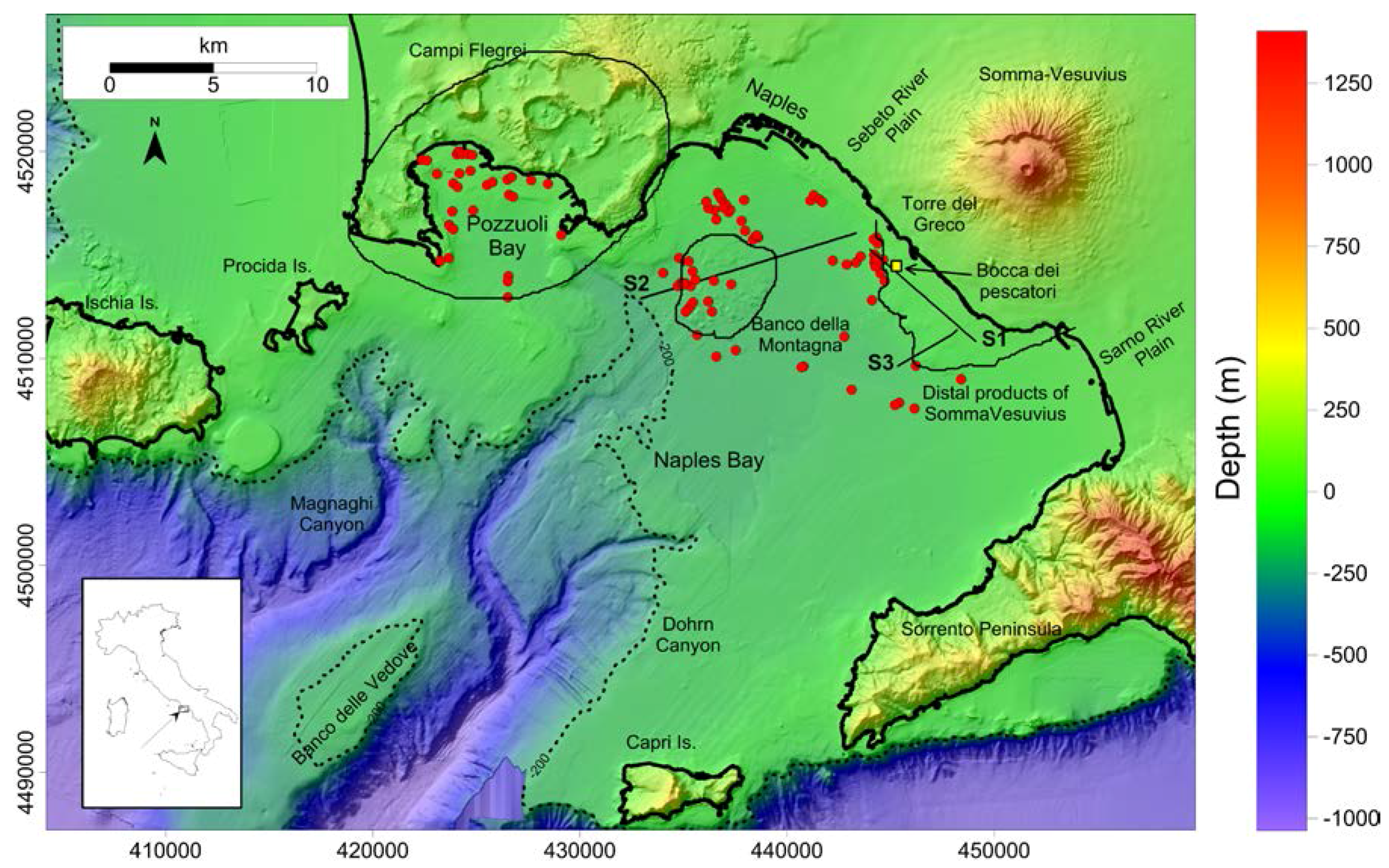
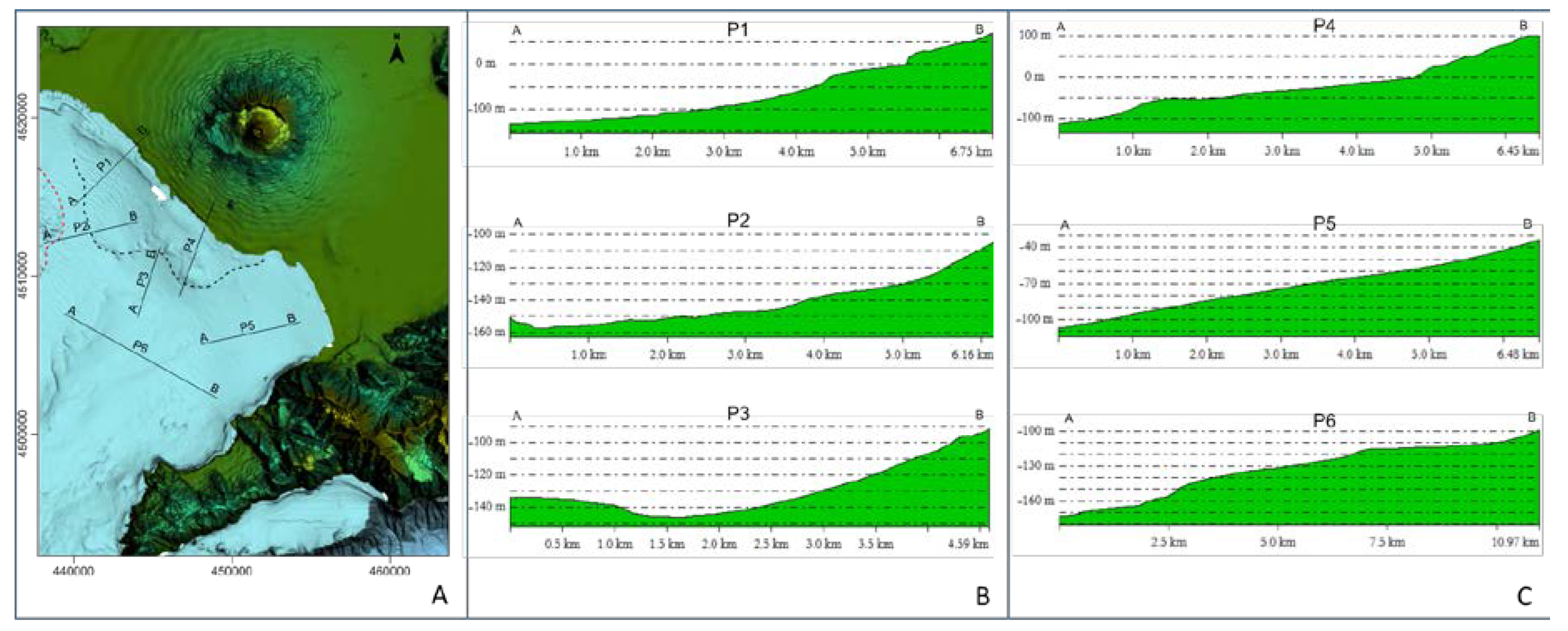
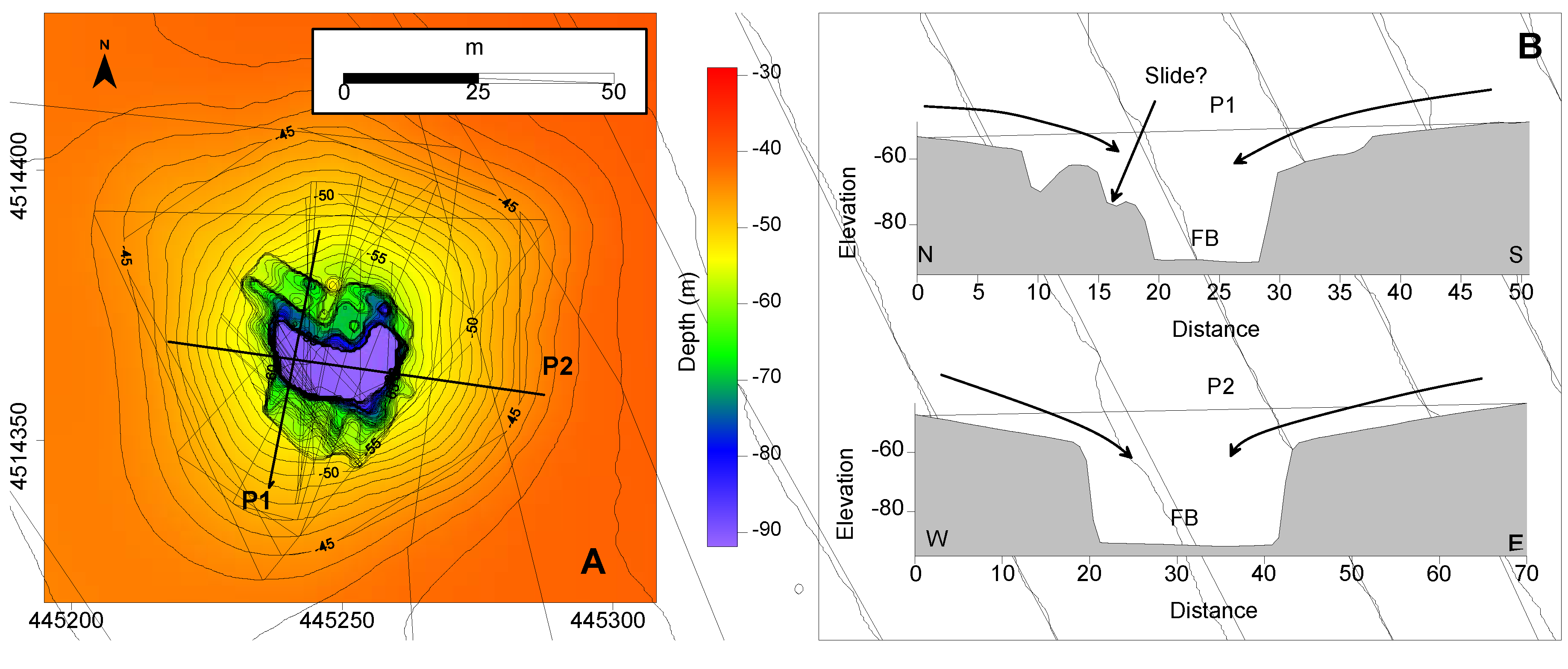
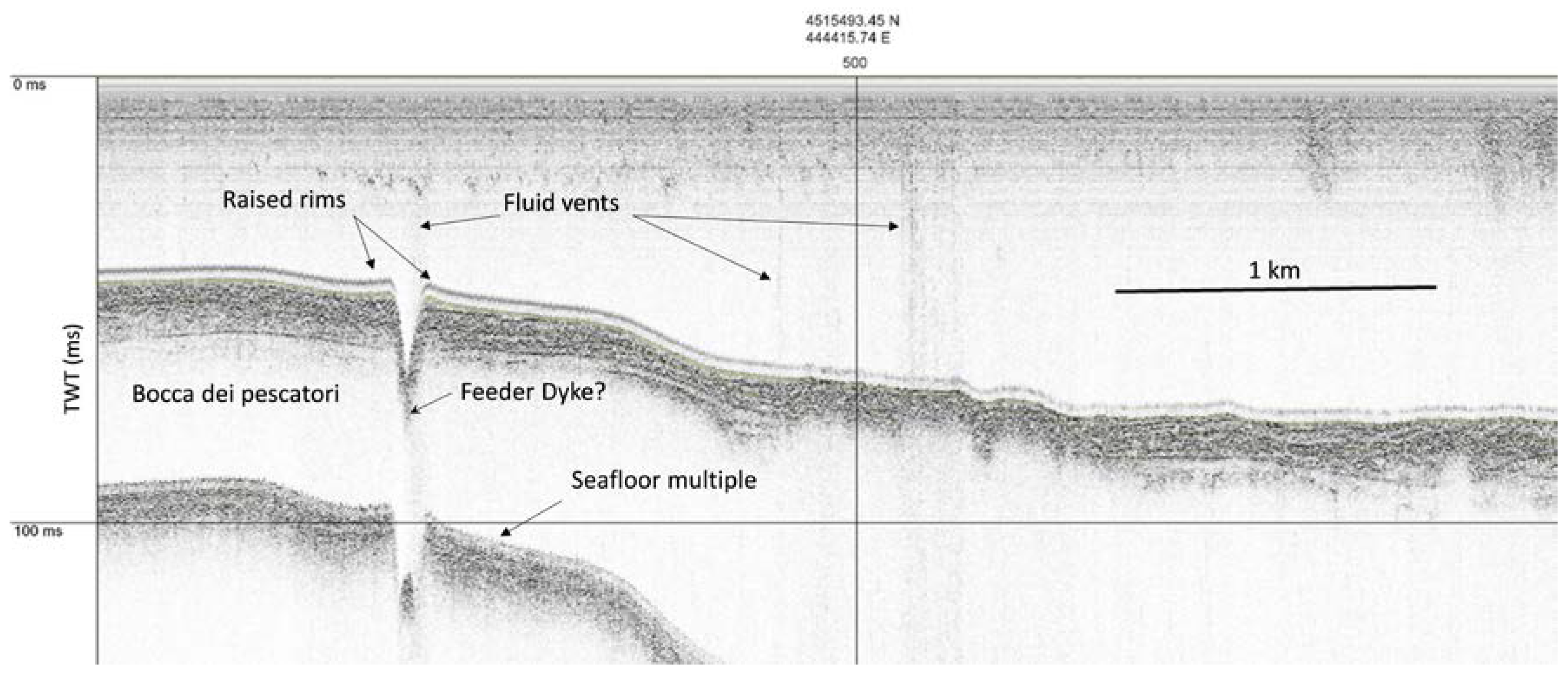
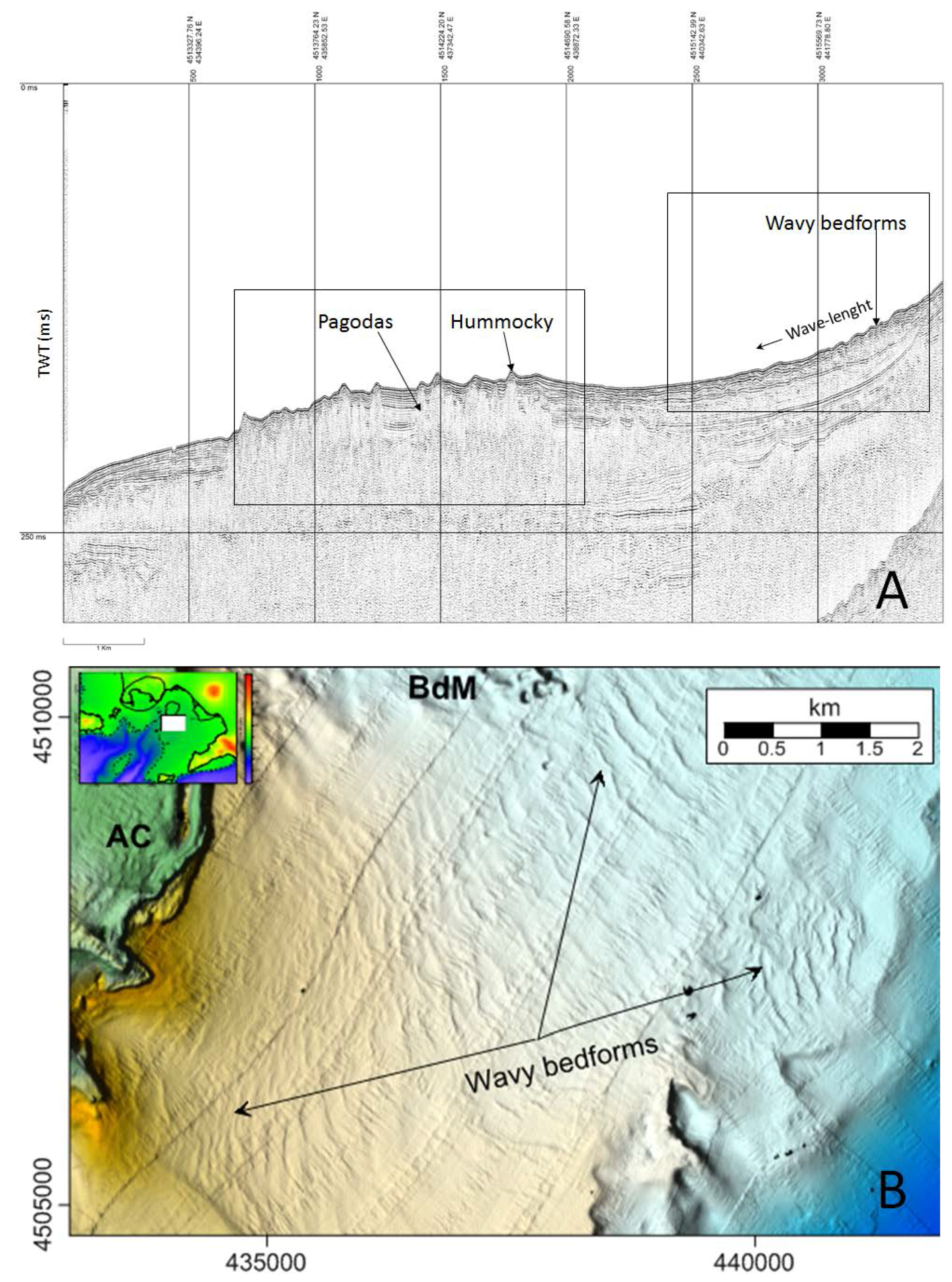

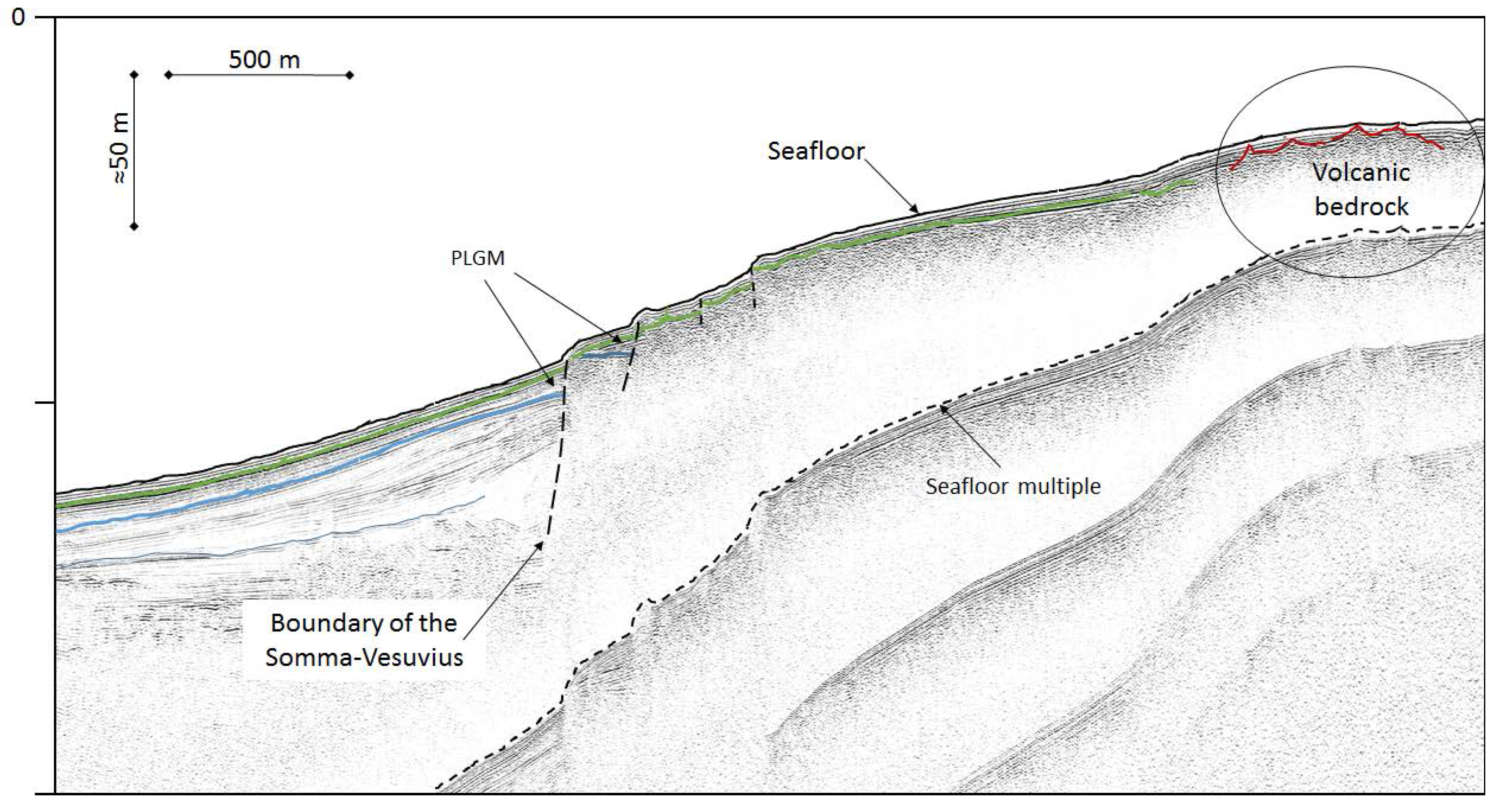
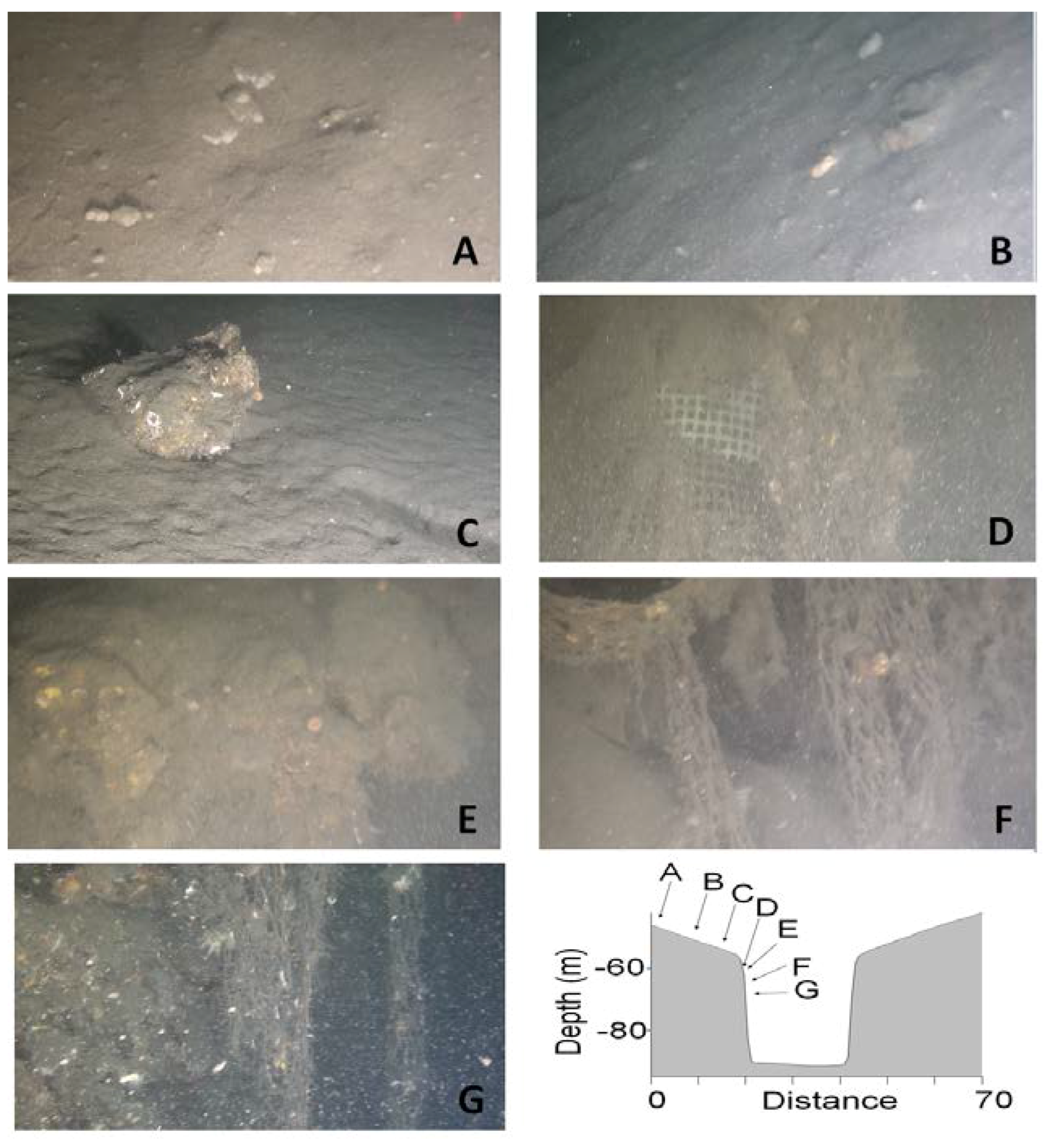
© 2018 by the authors. Licensee MDPI, Basel, Switzerland. This article is an open access article distributed under the terms and conditions of the Creative Commons Attribution (CC BY) license (http://creativecommons.org/licenses/by/4.0/).
Share and Cite
Passaro, S.; Sacchi, M.; Tamburrino, S.; Ventura, G. Fluid Vents, Flank Instability, and Seafloor Processes along the Submarine Slopes of the Somma-Vesuvius Volcano, Eastern Tyrrhenian Margin. Geosciences 2018, 8, 60. https://doi.org/10.3390/geosciences8020060
Passaro S, Sacchi M, Tamburrino S, Ventura G. Fluid Vents, Flank Instability, and Seafloor Processes along the Submarine Slopes of the Somma-Vesuvius Volcano, Eastern Tyrrhenian Margin. Geosciences. 2018; 8(2):60. https://doi.org/10.3390/geosciences8020060
Chicago/Turabian StylePassaro, Salvatore, Marco Sacchi, Stella Tamburrino, and Guido Ventura. 2018. "Fluid Vents, Flank Instability, and Seafloor Processes along the Submarine Slopes of the Somma-Vesuvius Volcano, Eastern Tyrrhenian Margin" Geosciences 8, no. 2: 60. https://doi.org/10.3390/geosciences8020060
APA StylePassaro, S., Sacchi, M., Tamburrino, S., & Ventura, G. (2018). Fluid Vents, Flank Instability, and Seafloor Processes along the Submarine Slopes of the Somma-Vesuvius Volcano, Eastern Tyrrhenian Margin. Geosciences, 8(2), 60. https://doi.org/10.3390/geosciences8020060






